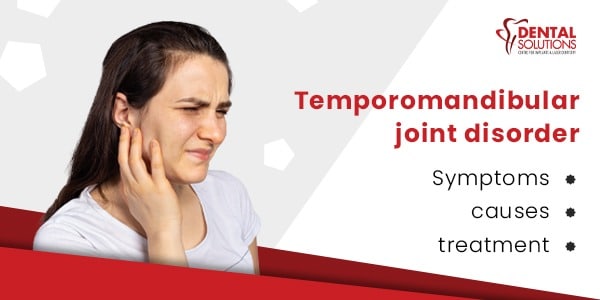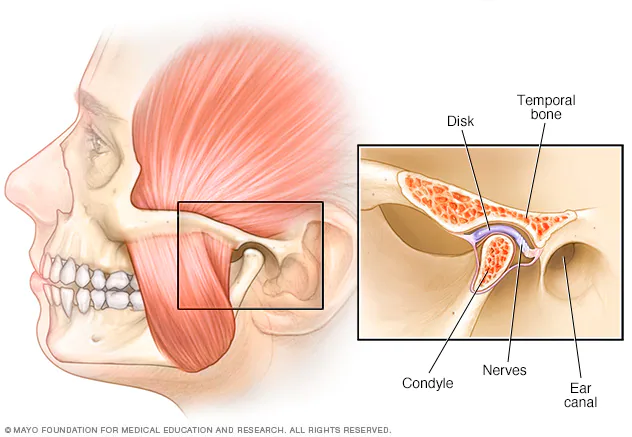Temporomandibular disorder TMD – Symptoms Causes and Treatment

The acronym TMD stands for temporomandibular disorder.
Chronic facial discomfort is often accompanied by a condition known as temporomandibular disorder (TMD), which refers to a group of conditions affecting the jaw muscles, temporomandibular joints, and nerves. Temporomandibular disorders can be caused by virtually any condition that disrupts the normal coordination and cooperation of the body's intricate network of muscles, bones, and joints.
The National Institute of Dental and Craniofacial Research says the following about Temporomandibular Disorder (TMD):
- Myofascial pain: This is by far the most common presentation of TMD. It causes discomfort or soreness in the fascia, which is the connective tissue that covers the muscles, as well as in the muscles that control the function of the jaw, neck, and shoulders.
- Dislocation of the joint's internal structures: This means that the jaw is out of place and that the condyle, a cushion of cartilage between the head of the jaw bone and the skull (the rounded end of the jaw bone that connects to the temporal skull bone), has been hurt.
- Degenerative joint disease. This includes conditions such as osteoarthritis and rheumatoid arthritis, which affect the jaw joint.
What exactly are the temporomandibular joints, also known as the TMJ?
Before we talk about the temporomandibular disorder or TMD let's first know what are temporomandibular joints (TMJ). These are the two joints that connect your lower jaw to your skull. They are also known as the jaw joints. To be more exact, they are the joints that slide and rotate in front of each ear, and they are comprised of the mandible (also known as the lower jaw) and the temporal bone (the side and base of the skull).

The temporomandibular joints (TMJs) are one of the most complicated joints in the body. With the help of these joints and a number of muscles, the mandible is able to move in all directions, including up and down, side to side, and forward and back. Chewing, talking, yawning, and swallowing are just a few of the smooth muscle activities that are made possible when the mandible and the joints are in the correct alignment. If the structures in question (muscles, ligaments, disk, jaw bone, and temporal bone) are not properly aligned and their movements are not in sync with each other, it can cause a number of problems.
Who is affected by Temporomandibular disorder or TMD?
Even though both men and women can suffer from these conditions, it is women in their childbearing years that are more likely to have the most severe symptoms. With significant restrictions placed on jaw movement and persistent, unyielding pain, the proportion of female patients to male patients approaches nine to one. This occurs when the severity of the symptoms is at its highest.
What are the Symptoms of TMD or Temporomandibular disorder
1. Muscle aches and pains in the jaw
2. Muscle pain in the back, neck, and shoulders
3. Headaches that don't go away.
4. Jaw muscle tightness.
5. Restriction of jaw mobility or locking of the jaw.
6. Symptoms such as earache, pressure, fullness, and ringing in the ears (tinnitus)
There is a noise that can be heard in the jaw joint when the mouth is opened or closed.
7. A mouthful that just doesn't seem right.
8. Dizziness
9. Eyesight troubles
It is important to keep in mind that soreness or occasional clicking in the jaw joint or the muscles used for chewing is normal and is not necessarily a cause for concern. The issue will typically be resolved on its own in a few weeks to a few months' time.
What exactly are the root causes of TMJ disorders?
1. Autoimmune disorders are conditions in which the patient's own immune cells assault and destroy healthy tissue.
2. Infections
3. Traumatic injuries to the jaw and its surrounding area.
4. Dental procedures (even prolonged mouth opening)
5. The placement of a breathing tube prior to surgical intervention
6. A number of particular inflammatory diseases (arthritis)
In addition, there are genetic factors, hormonal factors, and environmental factors that can all contribute to an increased chance of developing TMJ. Research has demonstrated that hereditary factors play a contributing role in TMJ, and these findings are leading to the discovery of innovative approaches to treat TMJ.
As a result of the fact that women in their childbearing years had a higher incidence of experiencing jaw issues, there has been an increase in the number of studies conducted to investigate the function that female sex hormones, notably estrogen, play in TMJ.
How are diseases of the TMJ or temporomandibular disorder treated?
In the same way that TMJ issues can have a number of different origins, there are also a number of different strategies to treat them.
In most cases, medical professionals will recommend initiating treatment at home first. This is because many of the more complicated treatments still need more research to prove that they work.
Remedies performed at home: In many instances, the symptoms of TMJ disorders are amenable to treatment at home through the use of self-care activities. At home, you can alleviate some of the symptoms of TMJ by:
- Take in some soft foods.
- Applying ice will help decrease any swelling.
- Take your jaw movements down a notch.
- Avoid chewing gum and foods that require a lot of chewing (like beef jerky).
- Make an effort to lower your stress levels.
- Exercises that stretch the jaw can help enhance the range of motion in the jaw.
Medication: If you find that treating your TMJ at home does not bring the relief you are looking for, you may find that taking medication, either over-the-counter or with a prescription from a medical professional, is more effective.
The following are examples of some of these medications:
- Nonsteroidal anti-inflammatory medications (NSAIDs)
- Corticosteroids
- Muscle relaxers
- Antidepressants
- Affixing a regional anesthetic
When you talk to your doctor about possible treatments, he or she will think about both your current condition and your medical history.
Therapies: Your physician may occasionally suggest that you participate in physical therapy. Depending on what needs to be fixed, the following things could be part of your therapy:
- Treatment with heat.
- Treatment, including chilling
- Acupuncture
- Tissue mobilization
- Resistance workouts
- Stretches
If you and your physician are of the opinion that the cause of your TMJ condition may be stress, additional choices to consider are talk therapy or exercises geared toward stress management.
Procedure or other types of procedures: Even if your doctor tries all of the above methods and your health doesn't get better, he or she may decide that you need more intensive treatment.
Injections of Botox are one example of such a treatment. These injections are typically administered for the treatment of painful trigger points or persistent teeth grinding. Despite this, there is not yet sufficient data to support this treatment. Trusted Source
Your medical professional may suggest surgery as a treatment option for your ailment in extremely unusual circumstances. These are some examples of procedures:
- In general dentistry, we work to realign your teeth and correct your bite in order to improve your oral health.
- Arthrocentesis, is often known as the removal of fluid and debris from the joint with a needle.
- A surgical procedure to replace the affected joint
It's possible that the procedures employed to treat this illness could end up making your symptoms much more severe. Talk to your primary care doctor about the possible side effects that these treatments could cause.
Takeaway
The prognosis of TMJ issues is highly dependent on the etiology of the illness. Many people using at-home therapies, such as adjusting their posture or taking steps to reduce their stress levels, can successfully treat TMJ issues.
Changing your lifestyle alone might not be enough to treat your problem if it is brought on by a condition that is chronic or long-lasting, such as arthritis. Arthritis can cause the joint to wear down over time, which can exacerbate pain. On the other hand, there are a great number of treatments available to help alleviate the symptoms of arthritis. The majority of cases with TMJ conditions call for adjustments in lifestyle behaviors, which may need to be supplemented with medicine to reduce pain and discomfort. The use of aggressive therapy is usually unnecessary.
Talk to your doctor or nurse about the different treatment options you have so that you can make an informed choice.
